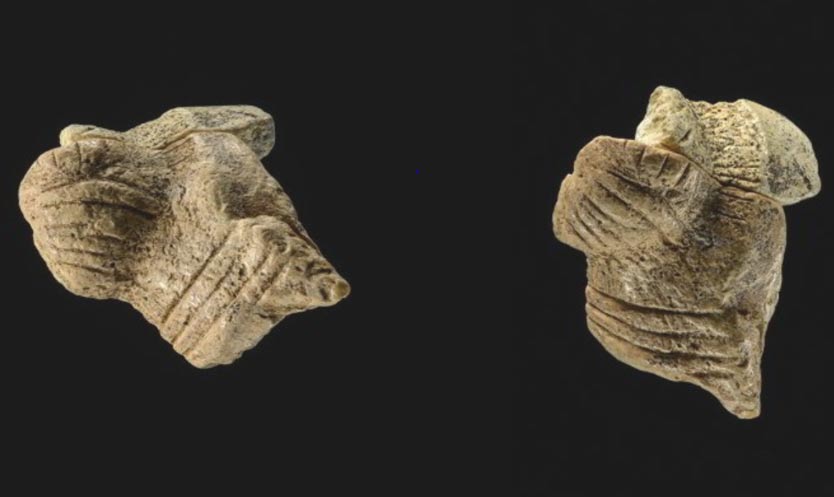Fragments of 40,000 year old female ‘Venus’ carving found
Two fragments of a prehistoric female figurine have been discovered in a cave at Hohle Fels in Germany. The figurine was carved from mammoth ivory and fit together to form an artifact measuring 23 mm by 22 mm by 13 mm in size. Other figurines found at this location date to 40,000 years ago and are therefore the oldest known depictions of humans.
The figurine appears to be similar to the well-known ‘Venus of Hohle Fels’, discovered by Professor Conard in 2009. Although it is more modest in its imagery it appears to have been taller. The recent discovery consists of a breast and part of the stomach. The artifacts can be traced back to the Aurignacian period when humans moved across Europe, displacing the Neanderthals as they went.

The Venus of Hohle Fels, Urgeschichtliches Museum (Wikimedia Commons)
“The new discovery indicates that the female depictions are not as rare in the Aurignacian as previously thought, and that concerns about human sexuality, reproduction and fertility in general have a very long and rich history dating to the Ice Age” Professor Conard told Past Horizons. Conard’s team of archaeologists have been involved with excavations at the Hohle Fels site for the past 19 years, thereby making this location one of the best known Palaeolithic sites in the world.
Hohle Fels is a well-known archaeological site located in south western Germany in an area known as the Swabian Jura or Swabian Alps, part of province of Baden-Württemberg. The area is also known for a number of other ancient sites, such as Geißenklösterle, Volgelherd, Sirgenstein, Brillenhöhle, and Bockstein. Artifacts found at these locations are the oldest known evidence of what archaeologists call ‘behavioural modernity’, that is to say advanced stone and bone tool technology, implements used for fishing, artifacts indicating care for the elderly and children, systematic burials, decorative objects and personal ornamentation and musical instruments, specifically the flute, and mobile and mural art.
- The Venus Figurines of the European Paleolithic Era
- 23,000-year-old statuette found in France adds to mysterious collection of 'Venus figurines'
- Study dismisses remarkable Neanderthal flute as the work of hyenas

Scientists say this bone flute found in the Hohle Fels cave dates back around 43,000 years. Credit: Jensen / University of Tubingen
The site shows signs of occupation since the Middle Paleolithic and Upper Paleolithic periods, but is best known for its Upper Paleolithic figurines, dating back to the Aurignacian period. In 2003, a carving of a horse head was found at the site which dated to about 30,000 years ago. Another carving depicted a water bird and a half human, half lion figurine. The horse head features deeply incised lines and cross hatching.
Around 100 ‘Venus’ figurines have been found in Europe, most of them in Russia and Central Europe. They are usually carved from bone, ivory or soft stone and distinguishing features include large breasts and large hips. Their heads are usually small and devoid of any obvious facial characteristics. Over the years, the precise meaning of these figures has often been a hot topic, a popular theory being that they represented fertility, either in a sexual sense or of the harvest or perhaps both. Most of them have been discovered in caves or open air settlements, rather than in ancient city sites.

A collection of Venus figures found across Europe (public domain)
The Venus of Hohle Fels was found in six fragments which when pieced together formed a figurine about 6 cm tall. In place of a head, it has a carefully carved ring which was carved in an off-centre position just above the shoulders. Archaeologists believe this indicates it was once worn round the neck as a pendant.
Professor Conard and his team have presented their findings in the journal Archäologische Ausgrabungen Baden-Württemberg. The artifact itself will be presented as part of a small research exhibition at the Museum of Prehistory in Blaubeuren.
Featured image: Fragments of a female figurine from Hohle Fels in south-western Germany dating to the Aurignacian period roughly 40,000 years ago. Images: J. Lipták/University of Tübingen.



















